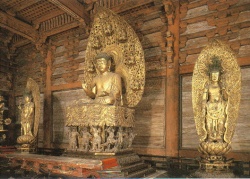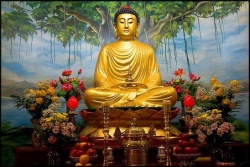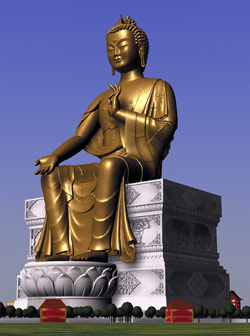Difference between revisions of "The Origin of Mahᾱyᾱna"
m (Text replacement - "]]]" to "]])") |
|||
| Line 5: | Line 5: | ||
[[Mahᾱyᾱna]] cannot be considered apart from what came before it, so let us consider the events prior to the 1st century B.C.E. | [[Mahᾱyᾱna]] cannot be considered apart from what came before it, so let us consider the events prior to the 1st century B.C.E. | ||
| − | The [[Buddha]] was born around 600 B.C.E. After 6 years of arduous seeking, he [[attained]] [[enlightenment]] at the age of 35. He then devoted the rest of his 45 years for the edification of [[beings]]. Three months after his [[parinibbᾱna]] ([[death]] and final release), 500 [[enlightened]] [[monks]] convened at [[Rājagaha]], [[India]], to recite the entire [[body]] of his teachings in what is now known as the 1st [[Buddhist Council]], during which [[Upāli]] recited the [[Vinaya]] Rules [[[monastic rules]] | + | The [[Buddha]] was born around 600 B.C.E. After 6 years of arduous seeking, he [[attained]] [[enlightenment]] at the age of 35. He then devoted the rest of his 45 years for the edification of [[beings]]. Three months after his [[parinibbᾱna]] ([[death]] and final release), 500 [[enlightened]] [[monks]] convened at [[Rājagaha]], [[India]], to recite the entire [[body]] of his teachings in what is now known as the 1st [[Buddhist Council]], during which [[Upāli]] recited the [[Vinaya]] Rules [[[monastic rules]]) whilst [[Ānanda]] recited the [[suttas]] [[[discourses]]). According to [[Ānanda]], before passing into [[parinibbᾱna]], the [[Buddha]] told him the [[monastic]] Order could abolish minor rules if it saw fit. However, [[Ānanda]] was so distraught at the [[time]] it did not occur to him to ask what rules they were. Thus, the leading [[monk]], Ven [[Mahᾱkāssapa]], adjudicated the rules should be best left unchanged. |
The 2nd [[Buddhist Council]] was held at [[Vesālī]] one hundred years later. Then, due to some unresolved controversial [[Vinaya]] issues the first {{Wiki|schism}} resulted in that some [[monks]] left to [[form]] the [[Mahāsaṅghika]] (the traditionalist school were known as the [[Sthaviravāda]]). By the [[time]] of the 3rd [[Buddhist Council]], convened by [[King]] [[Aśoka]] in the third century B.C.E at [[Pāṭaliputra]], there were at least eighteen schools with its own [[doctrines]]. The two dominated schools at the Council were the [[Vibhajyavādins]] and the [[Sarvāstivādins]], the Council favoured the former. Subsequently [[King]] [[Aśoka]] sent [[missionaries]] to [[Sri Lanka]], led by his son, Ven. [[Mahinda]], with the teachings of the [[Vibhajyavādins]] which later became known as [[Theravᾱda]]. | The 2nd [[Buddhist Council]] was held at [[Vesālī]] one hundred years later. Then, due to some unresolved controversial [[Vinaya]] issues the first {{Wiki|schism}} resulted in that some [[monks]] left to [[form]] the [[Mahāsaṅghika]] (the traditionalist school were known as the [[Sthaviravāda]]). By the [[time]] of the 3rd [[Buddhist Council]], convened by [[King]] [[Aśoka]] in the third century B.C.E at [[Pāṭaliputra]], there were at least eighteen schools with its own [[doctrines]]. The two dominated schools at the Council were the [[Vibhajyavādins]] and the [[Sarvāstivādins]], the Council favoured the former. Subsequently [[King]] [[Aśoka]] sent [[missionaries]] to [[Sri Lanka]], led by his son, Ven. [[Mahinda]], with the teachings of the [[Vibhajyavādins]] which later became known as [[Theravᾱda]]. | ||
[[File:M-bud10.jpg|thumb|250px|]] | [[File:M-bud10.jpg|thumb|250px|]] | ||
| − | Some {{Wiki|historians}} regard the [[Mahāsaṅghika]] as the progenitor of [[Mahᾱyᾱna]]. However, {{Wiki|modern}} [[scholars]] have shown that [[Mahᾱyᾱna]] did not result from {{Wiki|schisms}}. The {{Wiki|schisms}} that did occur were the result of [[Vinaya]] [[[monastic rules]] | + | Some {{Wiki|historians}} regard the [[Mahāsaṅghika]] as the progenitor of [[Mahᾱyᾱna]]. However, {{Wiki|modern}} [[scholars]] have shown that [[Mahᾱyᾱna]] did not result from {{Wiki|schisms}}. The {{Wiki|schisms}} that did occur were the result of [[Vinaya]] [[[monastic rules]]) rather than [[philosophical]] controversies. Paul Williams examines an early [[Mahᾱyᾱna]] text, the [[Ajitasena-vyᾱkaraṇa-nirdeśa Sūtra]], finds that it shows no [[animosity]] towards the previous [[tradition]], and points out the very [[gradual]] [[development]] of [[Mahᾱyᾱna]]. Popular support for [[Mahᾱyᾱna]] cannot be documented until the 4th or 5th century C.E. Furthermore, it seems that [[monks]] who lived in the same [[monasteries]] could have different [[doctrinal]] biases. Therefore, it seems [[Mahᾱyᾱna]] is not so much as a {{Wiki|distinct}} school of [[Buddhism]] but a different [[religious]] [[motivation]]. |
[[Mahᾱyᾱna]] texts were very open to lay religiosity and women were very much part of the new [[Mahᾱyᾱna]] trend. This led some to believe, and it is still a [[view]] common in [[Japan]], that it originates from a lay {{Wiki|movement}}. However, {{Wiki|modern}} [[scholars]] have shown that although the new texts are more open to [[lay people]] they were still composed by [[monks]]. For example, although the new texts commend the [[actions]] of [[wise]] lay [[Bodhisattvas]], they are still being urged to ordain and leave the lay [[life]] behind. Furthermore, Paul Harrison comments that 'although both men and women can ride in the [[Great Vehicle]] [Mahᾱyᾱna], only men are allowed to drive it' (Harrison, 1987: 76). Harrison’s paper in 1995 suggests the origin of [[Mahᾱyᾱna]] might have come from forest-dwelling [[ascetic]] [[monks]] attempting to return to the ideals of original [[Buddhism]].[1] | [[Mahᾱyᾱna]] texts were very open to lay religiosity and women were very much part of the new [[Mahᾱyᾱna]] trend. This led some to believe, and it is still a [[view]] common in [[Japan]], that it originates from a lay {{Wiki|movement}}. However, {{Wiki|modern}} [[scholars]] have shown that although the new texts are more open to [[lay people]] they were still composed by [[monks]]. For example, although the new texts commend the [[actions]] of [[wise]] lay [[Bodhisattvas]], they are still being urged to ordain and leave the lay [[life]] behind. Furthermore, Paul Harrison comments that 'although both men and women can ride in the [[Great Vehicle]] [Mahᾱyᾱna], only men are allowed to drive it' (Harrison, 1987: 76). Harrison’s paper in 1995 suggests the origin of [[Mahᾱyᾱna]] might have come from forest-dwelling [[ascetic]] [[monks]] attempting to return to the ideals of original [[Buddhism]].[1] | ||
| Line 23: | Line 23: | ||
The [[Lotus Sūtra]] is an extremely important text in Mahᾱyᾱna [[Buddhism]]. It has a wide influence in [[India]], [[China]], [[Japan]] and [[Vietnam]]. The important themes in this [[sūtra]] are [[compassion]] and [[skilful means]] which are two of the most important [[Wikipedia:concept|concepts]] in [[Mahᾱyᾱna]] [[Buddhism]]. By means of various [[parables]] the [[Lotus Sūtra]] tells us that out of [[compassion]] the [[Buddhas]] appear and pass away on [[earth]] when in fact they are [[eternal]] and [[supramundane]]. Thus, the [[historical Buddha]] [[Śhākyamuni]] was just an apparition created by the [[heavenly]] [[transcendental]] [[Buddha]] for the purpose of [[enlightening]] [[sentient beings]]. | The [[Lotus Sūtra]] is an extremely important text in Mahᾱyᾱna [[Buddhism]]. It has a wide influence in [[India]], [[China]], [[Japan]] and [[Vietnam]]. The important themes in this [[sūtra]] are [[compassion]] and [[skilful means]] which are two of the most important [[Wikipedia:concept|concepts]] in [[Mahᾱyᾱna]] [[Buddhism]]. By means of various [[parables]] the [[Lotus Sūtra]] tells us that out of [[compassion]] the [[Buddhas]] appear and pass away on [[earth]] when in fact they are [[eternal]] and [[supramundane]]. Thus, the [[historical Buddha]] [[Śhākyamuni]] was just an apparition created by the [[heavenly]] [[transcendental]] [[Buddha]] for the purpose of [[enlightening]] [[sentient beings]]. | ||
[[File:Maitreya project.jpg|thumb|250px|]] | [[File:Maitreya project.jpg|thumb|250px|]] | ||
| − | The [[Heart]] [[[Perfection of Wisdom]] | + | The [[Heart]] [[[Perfection of Wisdom]]) [[Sūtra]] takes up another important {{Wiki|concept}} in [[Mahᾱyᾱna]] [[Buddhism]], the ‘[[perfection of wisdom]]’, that is to say the [[transformation]] of [[wisdom]] into the ‘[[perfection of wisdom]]’. This reflects the [[ultimate reality]] and is characterised by [[emptiness]] ([[śūnyatā]]). ‘Ordinary [[wisdom]]’ allows us to realise that [[reality]] is made up of {{Wiki|individual}} components but [[perfection of wisdom]] allows us to see that even these {{Wiki|individual}} components are ‘[[empty]]’ because they have no [[Wikipedia:Absolute (philosophy)|ultimate]] [[existence]] as they are [[dependent upon]] the things that [[condition]] them. We can see this in everything around us. The dew drops, {{Wiki|stars}}, bubbles and lighting are the more obvious examples but if we {{Wiki|perceive}} and [[contemplate]] correctly, we would find that without exception everything that [[exists]] does so because of [[conditions]]. Thus, nothing inherently [[exists]], or putting it another way, all that [[exists]] is [[empty]] (of [[inherent]] [[existence]]). |
| − | The third ‘foundational’ [[Mahᾱyᾱna]] text, the [[Laṅkāvatāra Sūtra]], tells us that what all we can know and [[experience]] in [[Saṃsāra]] [[[Conditioned existence]] | + | The third ‘foundational’ [[Mahᾱyᾱna]] text, the [[Laṅkāvatāra Sūtra]], tells us that what all we can know and [[experience]] in [[Saṃsāra]] [[[Conditioned existence]]) is the [[mind]]. This [[Sūtra]] [[forms]] the [[Wikipedia:canonical|canonical]] foundation of the [[Cittamᾱtra]] [[[Mind-Only]]) school. According to the [[Laṅkāvatāra Sūtra]], our inability to free ourselves from discriminating between [[object]] and [[subject]] [[causes]] us to undergo [[births]] and [[rebirths]], and [[enlightenment]] is only [[attained]] by freeing ourselves from this [[dualistic]] {{Wiki|discrimination}}. The [[Laṅkāvatāra Sūtra]] also tells us that the [[mind]] is intrinsically [[pure]], but {{Wiki|discrimination}} defiles it. This is similar to [[impurities]] found in {{Wiki|gold}} ore, which have to be removed to reveal the [[brightness]] and shining [[nature]] of {{Wiki|gold}}. This means that the [[minds]] of [[beings]] are intrinsically [[pure]], and all have the potential for [[Buddhahood]]. This appealing {{Wiki|concept}} may partly explain the [[popularity]] of [[Mahᾱyᾱna]]. To sum up, the main features in [[Mahᾱyᾱna]] [[Buddhism]] are: |
1. The advocate of the [[Bodhisattva ideal]] | 1. The advocate of the [[Bodhisattva ideal]] | ||
| Line 43: | Line 43: | ||
[[Mahᾱyᾱna]] and ‘Early’ [[Buddhism]] | [[Mahᾱyᾱna]] and ‘Early’ [[Buddhism]] | ||
| − | What appeared above might seem a far cry from ‘Early’ [what came before [[Mahᾱyᾱna]] | + | What appeared above might seem a far cry from ‘Early’ [what came before [[Mahᾱyᾱna]]) [[Buddhism]]. As innovative as they seem, yet all the important [[Wikipedia:concept|concepts]] can be traced back to [[Early Buddhism]]. |
| − | In [[Early Buddhism]], the Jᾱtakas [stories of the [[Buddha’s]] former [[lives]] | + | In [[Early Buddhism]], the Jᾱtakas [stories of the [[Buddha’s]] former [[lives]]) give us inspiring examples of the trials and [[forbearance]] of the [[Bodhisattva]]. There are over 500 stories of the [[Buddha’s]] former [[lives]] in the Jᾱtakas, each provide a moving and inspiring [[moral]] lesson of how the power of good overcomes [[evil]] and the importance of integrity over [[fame]] and [[fortune]]. It is therefore not surprising that the [[Bodhisattva ideal]] came to be highly extolled. |
[[Early Buddhism]] also extols the systemic [[cultivation]] of the [[Brahmaviharᾱ]] [[[Divine]] Abiding] which entails developing [[loving kindness]] | [[Early Buddhism]] also extols the systemic [[cultivation]] of the [[Brahmaviharᾱ]] [[[Divine]] Abiding] which entails developing [[loving kindness]] | ||
Latest revision as of 22:18, 4 April 2016
Bodhi Journal: 8th Issue (Jun, 2008) - Early Mahayana Sutras by Scott Quyen Ngo 2012-06-03
Mahᾱyᾱna cannot be considered apart from what came before it, so let us consider the events prior to the 1st century B.C.E.
The Buddha was born around 600 B.C.E. After 6 years of arduous seeking, he attained enlightenment at the age of 35. He then devoted the rest of his 45 years for the edification of beings. Three months after his parinibbᾱna (death and final release), 500 enlightened monks convened at Rājagaha, India, to recite the entire body of his teachings in what is now known as the 1st Buddhist Council, during which Upāli recited the Vinaya Rules [[[monastic rules]]) whilst Ānanda recited the suttas [[[discourses]]). According to Ānanda, before passing into parinibbᾱna, the Buddha told him the monastic Order could abolish minor rules if it saw fit. However, Ānanda was so distraught at the time it did not occur to him to ask what rules they were. Thus, the leading monk, Ven Mahᾱkāssapa, adjudicated the rules should be best left unchanged.
The 2nd Buddhist Council was held at Vesālī one hundred years later. Then, due to some unresolved controversial Vinaya issues the first schism resulted in that some monks left to form the Mahāsaṅghika (the traditionalist school were known as the Sthaviravāda). By the time of the 3rd Buddhist Council, convened by King Aśoka in the third century B.C.E at Pāṭaliputra, there were at least eighteen schools with its own doctrines. The two dominated schools at the Council were the Vibhajyavādins and the Sarvāstivādins, the Council favoured the former. Subsequently King Aśoka sent missionaries to Sri Lanka, led by his son, Ven. Mahinda, with the teachings of the Vibhajyavādins which later became known as Theravᾱda.
Some historians regard the Mahāsaṅghika as the progenitor of Mahᾱyᾱna. However, modern scholars have shown that Mahᾱyᾱna did not result from schisms. The schisms that did occur were the result of Vinaya [[[monastic rules]]) rather than philosophical controversies. Paul Williams examines an early Mahᾱyᾱna text, the Ajitasena-vyᾱkaraṇa-nirdeśa Sūtra, finds that it shows no animosity towards the previous tradition, and points out the very gradual development of Mahᾱyᾱna. Popular support for Mahᾱyᾱna cannot be documented until the 4th or 5th century C.E. Furthermore, it seems that monks who lived in the same monasteries could have different doctrinal biases. Therefore, it seems Mahᾱyᾱna is not so much as a distinct school of Buddhism but a different religious motivation.
Mahᾱyᾱna texts were very open to lay religiosity and women were very much part of the new Mahᾱyᾱna trend. This led some to believe, and it is still a view common in Japan, that it originates from a lay movement. However, modern scholars have shown that although the new texts are more open to lay people they were still composed by monks. For example, although the new texts commend the actions of wise lay Bodhisattvas, they are still being urged to ordain and leave the lay life behind. Furthermore, Paul Harrison comments that 'although both men and women can ride in the Great Vehicle [Mahᾱyᾱna], only men are allowed to drive it' (Harrison, 1987: 76). Harrison’s paper in 1995 suggests the origin of Mahᾱyᾱna might have come from forest-dwelling ascetic monks attempting to return to the ideals of original Buddhism.[1]
Characteristics of Mahᾱyᾱna
One distinctive feature of Mahᾱyᾱna is the advocate of the Bodhisattva (one who ascribes to become a Buddha) ideal as opposed to the Śrāvaka (one who aims to become an Arhat, an enlightened disciple) ideal. A Buddha has the capacity to teach and help others to attain enlightenment, but to become a Buddha takes an infinitely long time and perseverance, relative to becoming an Arhat. This is one of the reasons why Mahᾱyᾱnists consider themselves more superior and altruistic than those who follow the Śrāvaka path, seeking enlightenment for themselves.
The rise of Mahᾱyᾱna is evidenced in a series of new texts. Between the 2nd Council and the 1st century C.E. saw the growth of a number of important Mahᾱyᾱna texts beginning with works like the Lalitavistara and Mahᾱvastu, which describe the career of the Buddha in exalted, supra-mundane terms. However, three very important ‘foundational’ Mahᾱyᾱna texts are: the Lotus Sūtra (Saddharma-puṇḍarika Sūtra), the Heart Sūtra (Prajñᾱpᾱramitᾱ Hṛidaya Sūtra), and the Laṅkāvatāra Sūtra.
Justification for the new texts is the belief in continuing revelation. Many of the important Mahᾱyᾱna texts were believed to have been related by Maitreya the future Buddha and other celestial Bodhisattvas or preserved among the serpent gods of the underworld until their discovery by Mahᾱyᾱna masters such as Nᾱgᾱrjuna. It would have been likely that these new texts received critical comments from ‘traditional’ Buddhists. Indeed, perhaps as a reaction to accusations by the previous tradition, Mahᾱyᾱna authors adopted the use of the pejorative term 'Hīnayāna’ which refers to the Śrāvaka path, perhaps at the time was directed at the most influential school, the Sarvāstivādins, whom are now extinct. The term Hīnayāna should not be used nowadays for reasons that it is both a depreciative and historically incorrect term to apply to any existing Buddhist traditions. We shall now turn to important doctrinal tenets found in the ‘foundational’ Mahᾱyᾱna texts.
The Lotus Sūtra is an extremely important text in Mahᾱyᾱna Buddhism. It has a wide influence in India, China, Japan and Vietnam. The important themes in this sūtra are compassion and skilful means which are two of the most important concepts in Mahᾱyᾱna Buddhism. By means of various parables the Lotus Sūtra tells us that out of compassion the Buddhas appear and pass away on earth when in fact they are eternal and supramundane. Thus, the historical Buddha Śhākyamuni was just an apparition created by the heavenly transcendental Buddha for the purpose of enlightening sentient beings.
The Heart [[[Perfection of Wisdom]]) Sūtra takes up another important concept in Mahᾱyᾱna Buddhism, the ‘perfection of wisdom’, that is to say the transformation of wisdom into the ‘perfection of wisdom’. This reflects the ultimate reality and is characterised by emptiness (śūnyatā). ‘Ordinary wisdom’ allows us to realise that reality is made up of individual components but perfection of wisdom allows us to see that even these individual components are ‘empty’ because they have no ultimate existence as they are dependent upon the things that condition them. We can see this in everything around us. The dew drops, stars, bubbles and lighting are the more obvious examples but if we perceive and contemplate correctly, we would find that without exception everything that exists does so because of conditions. Thus, nothing inherently exists, or putting it another way, all that exists is empty (of inherent existence).
The third ‘foundational’ Mahᾱyᾱna text, the Laṅkāvatāra Sūtra, tells us that what all we can know and experience in Saṃsāra [[[Conditioned existence]]) is the mind. This Sūtra forms the canonical foundation of the Cittamᾱtra [[[Mind-Only]]) school. According to the Laṅkāvatāra Sūtra, our inability to free ourselves from discriminating between object and subject causes us to undergo births and rebirths, and enlightenment is only attained by freeing ourselves from this dualistic discrimination. The Laṅkāvatāra Sūtra also tells us that the mind is intrinsically pure, but discrimination defiles it. This is similar to impurities found in gold ore, which have to be removed to reveal the brightness and shining nature of gold. This means that the minds of beings are intrinsically pure, and all have the potential for Buddhahood. This appealing concept may partly explain the popularity of Mahᾱyᾱna. To sum up, the main features in Mahᾱyᾱna Buddhism are:
1. The advocate of the Bodhisattva ideal
2. Compassion
3. Skilful means
4. The supra-mundane nature of the Buddhas
5. Emptiness (Śūnyatā)
6. Saṃsāra results from false discrimination
7. The universality appeal – all beings have the potential for Buddhahood.
Mahᾱyᾱna and ‘Early’ Buddhism
What appeared above might seem a far cry from ‘Early’ [what came before Mahᾱyᾱna) Buddhism. As innovative as they seem, yet all the important concepts can be traced back to Early Buddhism.
In Early Buddhism, the Jᾱtakas [stories of the Buddha’s former lives) give us inspiring examples of the trials and forbearance of the Bodhisattva. There are over 500 stories of the Buddha’s former lives in the Jᾱtakas, each provide a moving and inspiring moral lesson of how the power of good overcomes evil and the importance of integrity over fame and fortune. It is therefore not surprising that the Bodhisattva ideal came to be highly extolled.
Early Buddhism also extols the systemic cultivation of the Brahmaviharᾱ [[[Divine]] Abiding] which entails developing loving kindness
Edited by Aik TC 18 Jun `13, 10:24PM



